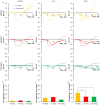Analysis of the Mechanisms Underlying the Specificity of the Variation Potential Induced by Different Stimuli
- PMID: 39458843
- PMCID: PMC11511009
- DOI: 10.3390/plants13202896
Analysis of the Mechanisms Underlying the Specificity of the Variation Potential Induced by Different Stimuli
Abstract
Plants are able to perceive diverse environmental factors and form an appropriate systemic functional response. Systemic responses are induced by stimulus-specific long-distance signals that carry information about the stimulus. Variation potential is proposed as a candidate for the role of such a signal. Here, we focus on the mechanisms that determine the specificity of the variation potential under the action of different local stimuli. Local stimuli such as heating, burning and wounding cause variation potential, the parameters of which differ depending on the type of stimulus. It was found that the stimulus-specific features of the hydraulic signal monitored by changes in leaf thickness and variation potential, such as a greater amplitude upon heating and burning and a significant amplitude decrement upon burning and wounding, were similar. The main features of these signals are the greater amplitude upon heating and burning, and a significant amplitude decrement upon burning and wounding. Together with the temporal correspondence of signal propagation, this evidence indicates a role for the hydraulic signal in the induction of stimulus-specific variation potential. Experiments using mechanosensitive channel inhibitors have demonstrated that the hydraulic signal contributes more to the induction of the variation potential in the case of rapidly growing stimuli, such as burning and wounding, than in the case of gradual heating. For thermal stimuli (gradual heating and burning), a greater contribution, compared to wounding, of the chemical signal related to reactive oxygen species to the induction of the variation potential was demonstrated. Thus, the specificity of the parameters of the variation potential is determined by the different contributions of hydraulic and chemical signals.
Keywords: abiotic stress; electrical signal; hydraulic signal; signal transduction; variation potential.
Conflict of interest statement
The authors declare no conflicts of interest.
Figures







Similar articles
-
Mechanisms of specific systemic response in wheat plants under different locally acting heat stimuli.J Plant Physiol. 2021 Mar-Apr;258-259:153377. doi: 10.1016/j.jplph.2021.153377. Epub 2021 Feb 6. J Plant Physiol. 2021. PMID: 33621780
-
Chemical signal as a rapid long-distance information messenger after local wounding of a plant?Plant Signal Behav. 2007 Mar;2(2):103-5. doi: 10.4161/psb.2.2.3616. Plant Signal Behav. 2007. PMID: 19704749 Free PMC article.
-
Systemic Signals Induced by Single and Combined Abiotic Stimuli in Common Bean Plants.Plants (Basel). 2023 Feb 17;12(4):924. doi: 10.3390/plants12040924. Plants (Basel). 2023. PMID: 36840271 Free PMC article.
-
Electrical Signaling of Plants under Abiotic Stressors: Transmission of Stimulus-Specific Information.Int J Mol Sci. 2021 Oct 3;22(19):10715. doi: 10.3390/ijms221910715. Int J Mol Sci. 2021. PMID: 34639056 Free PMC article. Review.
-
Wound-Induced Systemic Responses and Their Coordination by Electrical Signals.Front Plant Sci. 2022 May 18;13:880680. doi: 10.3389/fpls.2022.880680. eCollection 2022. Front Plant Sci. 2022. PMID: 35665138 Free PMC article. Review.
Cited by
-
New Insights into Plant Signaling Mechanisms in Biotic and Abiotic Stress.Plants (Basel). 2025 Jun 26;14(13):1953. doi: 10.3390/plants14131953. Plants (Basel). 2025. PMID: 40647962 Free PMC article.
References
Grants and funding
LinkOut - more resources
Full Text Sources

